Heart


Crest, mantling and motto of Lory Santiago-Vazquez
Party per fess wavy: 1 Azure, a dolphin naiant; 2 Argent, three escallops Azure. Crest: Upon a helm lined Azure with a wreath Argent and Azure, an owl Tenné, armed, beaked, membered, the eyes, and wearing a necklace with a pendant heart Or, grasping with its dexter foot a bluebonnet proper. Mantling Azure doubled Argent. Motto: «Compasión · Honor · Sabiduría» Azure, over a scroll Argent doubled Azure, fimbriated Or.
Coat of arms depicted by me, highlighted with lights and shadows, contoured in Sable, with a semi-circular external shape and with a leather finish.
Design rationale
She is an Associate Professor and Assistant Professor at the University of Houston-Clear Lake. She studied Marine Biology at the University of Puerto Rico, Humacao (1991–1995), and the marine motifs reflect both her academic training and career. The dolphin on the shield refers to her Puerto Rican heritage, her birthplace in Fajardo, and her personal value of honor. At her request, the shield ends in a semi-circular arch, in keeping with Hispanic heraldic tradition. The three escallops symbolize her family and her compassion. She currently resides in Houston, Texas, which is why the owl in her crest holds a bluebonnet (Lupinus texensis), the state flower of Texas since 1901. The owl represents her profession and her wisdom. A small gold heart on the chain pendant indicates her cadency as first daughter.
Blazon keywords: Azure, Argent, One, Three, Or, Party per fess, Wavy, Dolphin, Naiant, Escallop, Crest, Upon (wreath), Helm, Lined, Wreath, Owl, Tenné, Armed, Beaked, Membered, The eyes, Collar, Heart, Grasping, Dexter, Talon, Bluebonnet, Flower, Proper, Mantling, Doubled, Motto and Scroll.
Style keywords: Outlined in sable, Illuminated, Semi-circular and Leather.
Classification: Personal, Interpreted, Design rationale, Boa and Coat of arms.
Bearer: Santiago-Vazquez, Lory.


Heidi Garcia-Bosch-de Morales-de Sola née Adriaensen
Party per pale: 1 Gules, a bend sinister debruised by an inescutcheon Or charged with a bend Azure charged with five fusils palewise Argent, in base on a triangle Argent the Sacred Heart of Jesus proper [for Adriaensen]; 2 Azure, a fleur de lis Argent above a doe sejeant proper surrounded by twelve mullets in orle Or [granted by Bourbon-Parma]. Crest: A crown of Noble. Motto: «Biche délicate».
Coat of arms emblazoned by me with a lozenge shape, illuminated, and with a free hand finishing.
G0084, Chief Herald of Malta's grant of Heidi Garcia-Bosch-de Morales-de Sola née Adriaensen's arms, whose full achievement has been emblazoned by me for such grant.
Blazon keywords: Party per pale, Gules, One, Bend sinister, Or, In base, Triangle, Argent, Charged, Sacred Heart of Jesus, Heart enflamed, Heart, Enflamed, Proper, Overall, Inescutcheon, Bend, Azure, Five, Fusil, Palewise, Doe, Sejant, Above, Fleur de lis, Surrounded, Twelve, Mullet, In orle, Crest and mantling, Crown of Noble, Crown, Motto and Scroll.
Style keywords: Outlined in sable, Illuminated, Freehand and Rhombus.
Classification: Personal, Interpreted, Coat of arms, Latin language and Doctor.
Bearer: Garcia-Bosch-de Morales-de Sola née Adriaensen, Heidi.


Holy Trinity
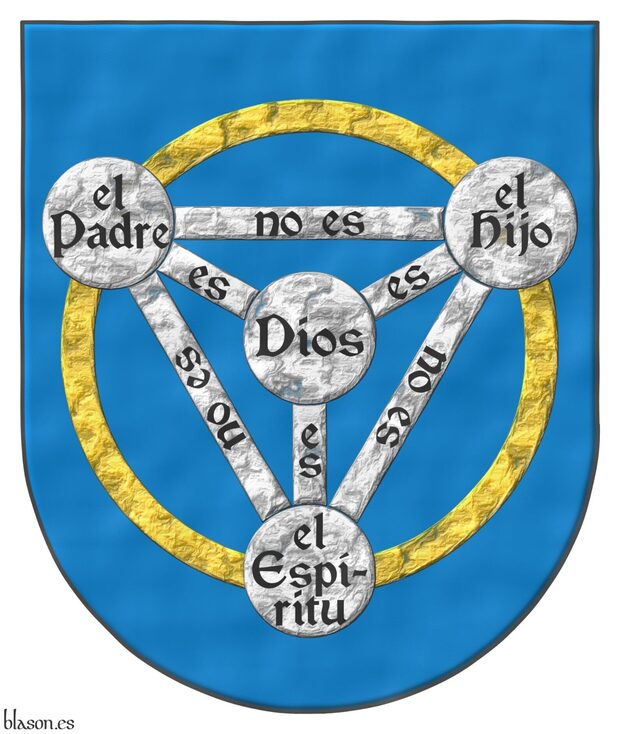
Azure, a pall couped Argent, its three arms charged with «es» Sable, within a triangle reversed Argent, its three arms charged with «no es» Sable, within an annulet Or, all debruised by four plates, three on the vertex of the triangle, in dexter chief, charged with «el Padre» Sable, in sinister chief, charged with «el Hijo» Sable, in base, charged with «el Espítiru» Sable, and one on the fess point, charged with «Dios» Sable.
Escudo de azur, una perla recortada de plata, sus tres brazos cargados con «es» de sable, dentro de un triángulo ranversado de plata, sus tres brazos cargados con «no es» de sable, dentro de un anillo de oro, todo resaltado de cuatro bezantes de plata, tres sobre los vértices del triángulo, en la diestra del jefe, cargado de «el Padre» de sable, en la siniestra del jefe, cargado con «el Hijo» de sable, en la punta, cargado con «el Espítiru» de sable y uno sobre el corazón, cargado con «Dios» de sable.
Imaginary coat of arms that I have interpreted as follows: its base is semicircular (round); its field is illuminated in watercolor Azure; the rest in heavily beaten metal, outlined of the field and illuminated in Argent, except for the annulet which is illuminated in Or; and its letters all in plain Gules ink.
Annulet
The circular crown when it is large and in the middle of the shield [Cadenas y Vicent, V. de; 1975] is called an annulet. [Avilés, J.; 1780a; pages 296 and 297] calls it annulet or small annulet depending on its size, if it is large an annulet and if it is small a small annulet. In English and French heraldry it is called «cyclamor» and hence the expression «cyclamor annulet» can also be found.
This annulet is my aesthetic contribution to this imaginary coat of arms as it is normally not represented with this annulet.
Bordure and Orle
In other interpretations the words «non est» go on a bordure or on an orle, the latter being the case blazoned, for example, [Husenbeth, F. C.; 1882; 2nd appendix] in the following way: «Gules, an orle and pall Argent, conjoined and surmounted of four plates, occupying the dexter and sinister chief and the base and fess points respectively; the first inscribed Pater, the second Filius, and the third Spiritus Sanctus, the centre Deus; the connecting portions of the orle between them having the words non est, and those of the pall est».
Blazon keywords: Without divisions, Azure, Cyclamor, Pall, Cerrado, Argent, Charged, Bezant and plate, Or, Dexter, Sinister, Chief, Base (lower 1/3) and Heart.
Style keywords: Semi-circular, Illuminated, Outlined in the field tincture, Watercolor and Hard metal.
Classification: Religious, Interpreted, Imaginary and Coat of arms.
Imaginary bearer: Holy Trinity.


Ifrah, Yishay
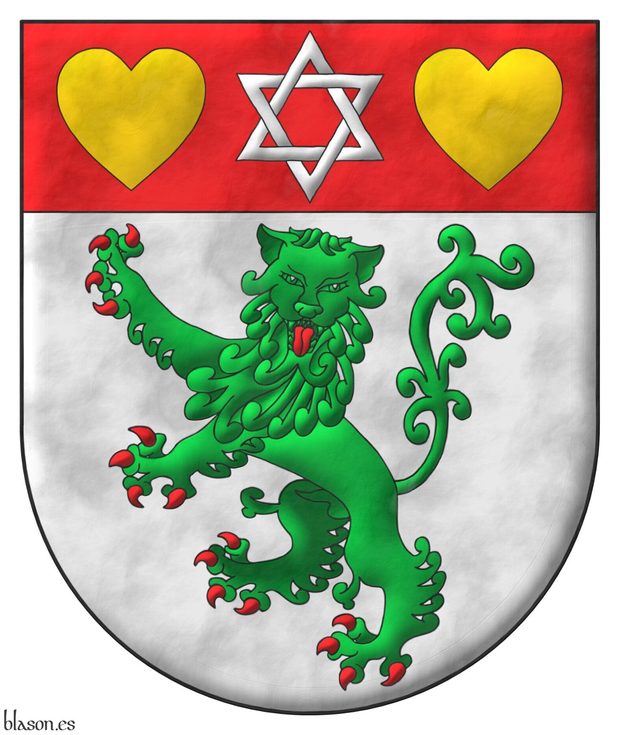
Argent, a lion rampant guardant Vert, armed and langued Gules; on a chief Gules, a mullet of six points voided, interlaced Argent between two hearts Or.
Escudo de plata, un leopardo leonado de sinople, armado y lampasado de gules; un jefe de gules cargado de una estrella de seis puntas, hueca y entrelazada de plata acompañada de dos corazones de oro.
Arms interpreted by me, illuminated with lights and shadows, outlined in Sable, with a semi-circular external shape and with a texturized finishing.
The coat of arms of Yishay Ifrah emblazoned by me. Alternative blazon: «Argent, a lion rampant guardant Vert, armed and langued Gules; a chief Gules charged with a star of David Argent between two hearts Or».
Blazon keywords: Argent, Vert, Gules, Or, One, Two, Lion rampant guardant, Armed, Langued, Chief, Charged, Star of David, Mullet, Voided, Interlaced, Between and Heart.
Style keywords: Outlined in sable, Illuminated and Semi-circular.
Classification: Personal, Interpreted, Boa and Coat of arms.
Bearer: Ifrah, Yishay.


Javier Fernández-Cortés y Fonseca, motto and nobility of Asturias
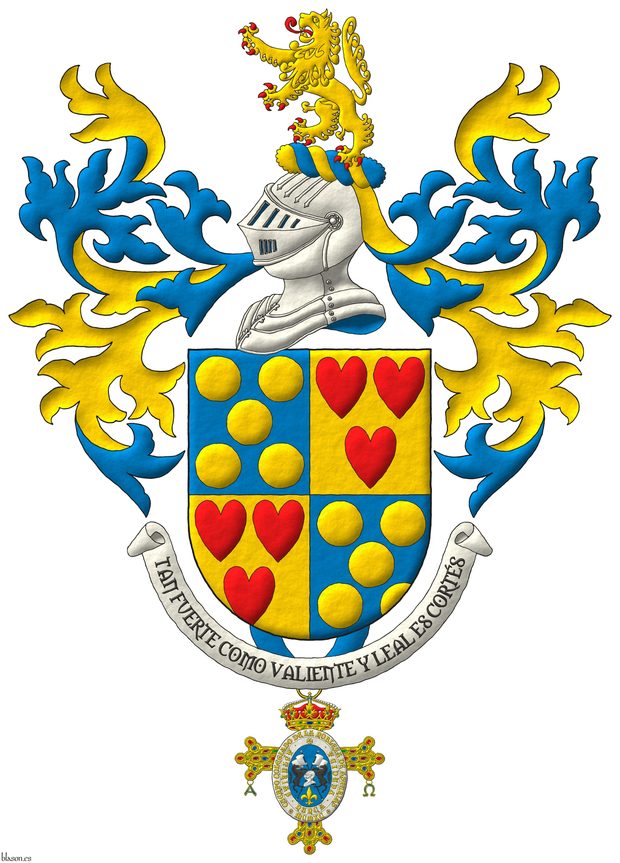
Quarterly: 1 and 4 Azure, five Bezants in saltire; 2 and 3 Or, three hearts Gules ordered. Crest: Upon a Helm Argent with a Wreath Or and Azure a Lion rampant Or, langued and armed Gules. Mantling: Azure doubled Or. Suspended from the base the insignia of the Cuerpo de la Nobleza del Principado de Asturias. Lema: «Tan fuerte como valiente y leal es Cortés».
Blazon keywords: Quarterly, Azure, Five, Bezant, Bezant and plate, In saltire, Or, Three, Heart, Gules, Ordered, Crest and mantling, Helm, Argent, Mantling, Wreath, Lion, Rampant, Langued, Armed, Suspended, Base (lower 1/3), Decoration and Motto.
Style keywords: Freehand, Semi-circular, Illuminated and Outlined in sable.
Classification: Coat of arms, Interpreted and Personal.
Bearer: Fernández-Cortés y Fonseca, Javier.


Jesus Christ, preparation schema

Schema for an imaginary coat of arms that will have the following characteristics: its base will be semicircular (round); it will contain a closed pearl charged with four bezants; and it will be differenced by a label of three points, which being three is normal, its number will not be specified in the blazon.
Label
The way to elaborate a label can be found in [Avilés, J.; 1780a; page 248] who writes that «it is made of a fillet, which is the ninth part of the latitude of the Chief with three points in the form of a Carpenter's wedge, or of badly formed triangles, which united to it without separation of lines, fall twice as much, as the fillet is wide, the two being placed at its ends, and one in its middle, its ordinary situation being in the middle of the length of the Chief itself, without reaching the edges of the Shield».
Label points
In [Avilés, J.; 1780a; pages 248 and 249] it is said that «the simple Label is always of three points», as is the case at hand, «but having 4, 5, or 6, which is the greatest number found, it is necessary to specify it», although in [Avilés, J.; 1780a; page 114] he seems to consider that the maximum is five as he writes «Points, it is said of three, four and up to five points of the Labels».
Blazon keywords: Without divisions, Pall, Cerrado, Charged, Bezant and plate, Dexter, Sinister, Chief, Base (lower 1/3), Heart and Label.
Style keywords: Semi-circular.
Classification: Religious, Schema, Interpreted and Imaginary.
Imaginary bearer: Jesus Christ.


![Ver [Latidos Podencos] en criterios utilizados. Unicornio saltante sobre la divisa, criterio.](../css/Unicornio.Criterio.png)
Latidos Podencos
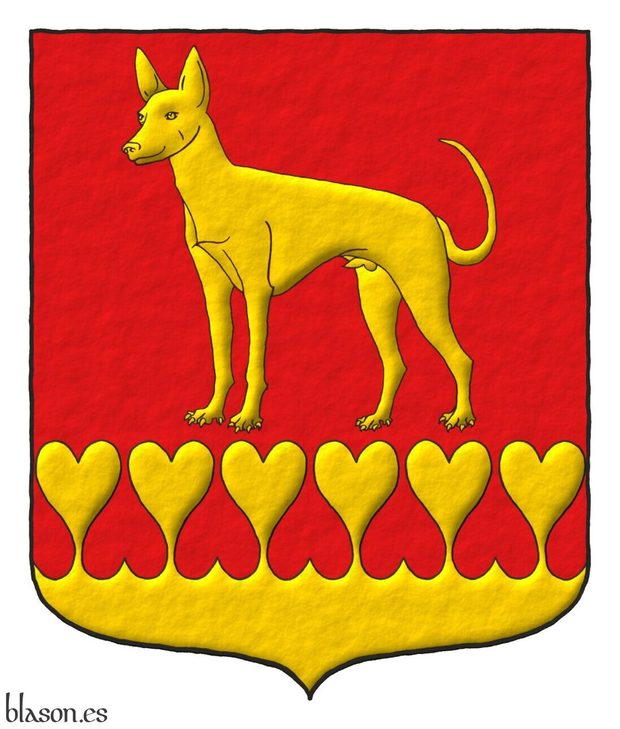
Gules: a warren hound parado statant Or; a base hearty Or.
Escudo de gules: un podenco parado de oro; la campaña encajada de corazones de oro.
Coat of arms that I have created with: the shield’s shape pointed and rounded; its field painted in flat tint gules; the warren hound and the base hearty are illuminated Or and delineated Sable; and the whole is executed in raised-line drawing.
Symbolism
A base made of generous hearts Or, interlocked with hearts Gules, red as blood, gives its support to a Spanish warren hound standing upon it. They are the hearts of those who love, protect and care for the hounds, intertwined with the hearts of the hounds whose noble heartbeats are evoked in the motto.
The founders of this Spanish warren hound shelter did not wish for a dog armed and langued, since those heraldic attributes would imply that the animal is not truly in need of protection. They preferred instead to highlight the podenco’s loyalty and faithfulness.
Types of lines of division
In English heraldry, ordinary lines of partition such as «almenado» ~ «embattled», «acanalado» ~ «invected», or «angrelado» ~ «engrailed» have well-established names. There is, however, no general rule for blazoning lines formed by repeated and more elaborate figures, such as fir trees, fleurs de lis, or other shapes.
Each case tends to receive a descriptive or newly coined term, such as «sapiné» or «flory» «flory counterflory», in these last two cases depending on whether the figures all point in one direction or alternate upward and downward.
Note that in «sapiné» the charm lies precisely in that alternation: the fir trees point alternately upward and downward, so that the figures interlock with each other.
Therefore, if a new figure appears, such as the heart in this case, with hearts pointing upward, one might say «hearty» or, more specifically, «hearty counterhearty»; but following the example of «sapiné», we shall simply blazon «hearty».
For example, the line formed by dovetail shapes, called «dovetailed» in English, is blazoned in Spanish as «encajada de colas de milano», even changing the name of the bird. Note that in this case they interlock precisely because some point upward and others downward, hence their use in joinery, cabinetry, and related arts.
In Spanish there are classical terms for the most common forms, such as «almenado», «acanalado» or «angrelado», with «encajado» ~ «dancetty» being perhaps the most characteristic, where the angles interlock alternately upward and downward.
When facing new or uncommon shapes, instead of inventing a new term we prefer to use the basic one, «encajado», adding afterwards the specific figure that forms the interlock, for example, «encajado de abetos» ~ «sapiné».
Thus, in this case we blazon «the base hearty», with the hearts alternating upward and downward, just as in the traditional «encajado» the angles alternate both ways.
Blazon keywords: Without divisions, Gules, Or, Warren hound, Dog, Base, Base (lower 1/3), Dancetty and Heart.
Style keywords: Ogee, Illuminated, Outlined in sable and Freehand.
Classification: Created, Socioeconomic, Design rationale, Criterion and Coat of arms.
Bearer: Latidos Podencos.


Oratorio de San Felipe Neri
Design rationale
Argent, in chief an ecclesiastical cap Sable, in base a heart enflamed gules.
This is the coat of arms of the Congregacion del Oratorio de San Felipe Neri of Alcala de Henares, «Congregatio Oratorii Sancti Philippi Nerii - Complutum», designed and emblazoned by me following their ideas and directions.
It is based on their original seal and other elements of the Oratory:
- the cap from the altar,
- the flaming heart from the carved wood of the candelabrum of the Chapel of Saint Philip Neri, and
- the layout and composition from the grey cast iron of the pulpit.
Blazon keywords: Argent, In chief, One, Ecclesiastical cap, Sable, In base, Heart enflamed, Heart, Enflamed and Gules.
Style keywords: Outlined in sable, Illuminated and Watercolor.
Classification: Religious, Created, Coat of arms and Photographic.
Bearer: Congregación del Oratorio de San Felipe Neri de Alcalá de Henares.


Tariq Abbasi
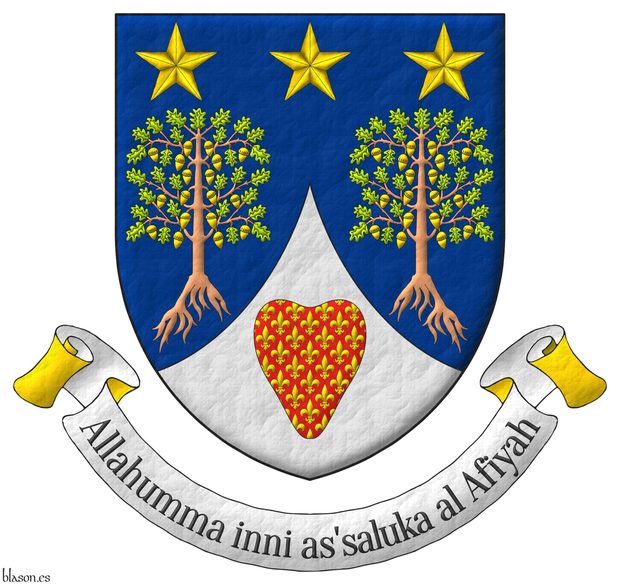
Azure, two oak trees eradicated proper, leaved Vert, fructed Or, in chief three mullets Or; enté en point Argent, a heart Gules semé of fleurs de lis Or. Motto: «Allahumma inni as'saluka al Afiyah» Sable over a scroll Argent doubled Or.
Escudo de azur, dos robles arrancados al natural, hojados de sinople, frutados de oro, en jefe, tres estrellas de cinco puntas de oro; entado en punta de plata, un corazón de gules sembrado de flores de lis de oro. Lema: «Allahumma inni as'saluka al Afiyah» de sable sobre una filacteria de plata doblada de oro.
Arms interpreted by me, illuminated with lights and shadows, outlined in Sable, with a pointed outer contour and with a leather finish.
The coat of arms and motto of Dr. Tariq Abbasi MBE FRSA designed by Vittorio Gifra and emblazoned by me.
Blazon keywords: Azure, Vert, Or, Argent, Gules, One, Two, Three, Oak, Tree, Eradicated, Proper, Leaved, Fructed, In chief, Mullet, Enté en point, Heart, Semé, Fleur de lis, Motto and Scroll.
Style keywords: Outlined in sable, Illuminated, Pointed and Leather.
Classification: Personal, Interpreted, Boa and Coat of arms.
Bearer: Abbasi, Tariq.
-
Language
-
Categories of heraldry
-
Divisions of the field
- Without divisions
- Party per pale
- Party per fess
- Party per bend
- Party per bend sinister
- Tierce
- Tierce sinister
- Tierced per pale
- Tierced per fess
- Tierced per bend
- Tierced pallwise inverted
- Quarterly
- Quarterly per saltire
- Gyronny
- Party per fess, the chief per pale
- Party per pale, the sinister per fess
- Party per fess, the base per pale
- Party per pale, the dexter per fess
- Chapé
- Chaussé
- Embrassé
- Contre-embrassé
- Party per chevron
- Enté
- Enté en point
- Flanched
-
Metals
-
Colours
-
Furs
-
Other tinctures
-
Ordinaries and sub-ordinaries
-
Diminutives of the ordinaries
-
Other charges
-
Charges from Nature
Water, Eagle, Bald eagle, Eagle claw, Dorsal fin, Tail fin, Two hands clasped, Lark, Tree, Trunk, Rainbow, Atom, Barbel, Acorn, Bighorn sheep, Arm, Owl, Vulture, Horse, Head, Goat, Camellia, Thistle, Merino ram, Kapok tree, Stag, Doe, Crescent, Increscent, Chrysanthemum, Tail, Tail addorsed, Ermine spot, Hummingbird, Snowflake, Heart, Roe deer, Neck, Stags' attires, Roe deers' attires, Raven, Dolphin, Diamond, Tooth, Elephant, Trunk (elephant), Beetle, Emerald, Starling, Mullet, Mullet of four points, Star of David, Estoile, Male figure, Fleur de lis, Flower, Cornflower, Dogwood flower, Lotus flower, Hop cone, Bluebonnet, Puffin, Ash, Rooster, Claw, Talon, Goose, Heron, Seagull, Pomegranate, Sunflower, Swallow-tail, Falcon, Leaf, Boar, Goldfinch, Laurel, Barn owl, Lion, Lioness, Lion passant, Leopard, Lion rampant guardant, Lynx, Lily, Madonna lily, Flame, Wolf, She-wolf, Parrot, Moon, Hand, Apple, Apple tree, Sea, Martlet, Wing, Two wings in vol, Covert, Blackbird, Mount, Trimount, Fly, Wrist, Elm, Olive tree, Orbital, Bear, Palm frond, Palm tree, Dove, Poplar leaf, Panther, Jaguar, Vine, Paw, Forepaw, Foot (palmiped), Foreleg, Peacock, Chest, Pelican, Pelican in her piety, Dog, Brach hound, Warren hound, Fish, Hoof, Beak, Feather, Ostrich feather, Cinquefoil, Quetzal, Branch, Sprig, Frog, Shamrock, Caboshed, Oak, Holm oak, Rose, Double rose, Savage, Serpent, Plough of Ursa Major, Sun, Sun in splendour, Ray of the sun, Lightning flash, River, Stem, Badger, Tyger, Linden, Wheat, Wheat spike, Bull, Tulip, Udder, Escallop and Fox.
-
Artificial charges
Halberd, Plough share, Ace of spades, Anchor, Cyclamor, Torch, Bow, Arch, Harp, Non-classic artifact, Winnowing fan, Crozier, Conductor's baton, Pair of scales, Ship, Oar, Sail, Norman ship, Beret, Grenade, Ecclesiastical cap, Arm vambraced, Knight, Chain, Cup, Covered cup, Monstrance, Bell, Bell tower, Cannon, Cannon dismounted, Cannon port, Carbuncle, Castle, Ribbon, Clarion, Nail, Crucible, Cord, Dagger, Key ward, Turret, With a turret, Armillary sphere, Sword, Federschwert, Sabre, Parchment, Scroll, Skirt, Arrow, Club, Garb, Sheaf of tobacco, Scythe, Gauntlet, Axe, Buckle, Galician granary, Host, Bonfire, Polish winged hussar, Church, Fanon, Oil lamp, Spear, Spear's head, Fleam, Letter, Book, Open book, Closed book, Bookmark, Page, Line, Lantern, Key, Four crescents joined millsailwise, Hammer, Two-handed sword, Menorah, Mortar, Pestle, Number, Knot, Celtic Trinity knot, Water-bouget, Comb, Piano, Millstone, Millrind, Millwheel, Quill, Clay pot, Potent, Bridge, Cuffed, Hourglass, Chess rooks, Compass rose, Rosette of acanthus leaves, Mullet of six points pierced, Broken, Portcullis, Wheel, Wagon-wheel, Symbol, Sackbut, Drum, Loincloth, Geometric solid, Tetrahedron, Tower, Trident, Trumpet, Double vajra and Anvil.
-
Immaterial charges
Angel, Archangel, Basilisk, Heart enflamed, Sacred Heart of Jesus, Paschal lamb, Dragon's head, Dragon, Wyvern, Phoenix, Garuda, Griffin, Sea-griffin, Winged hand, Our Lady of Mercy, Pegasus, Saint George, Mermaid, Trinity, Triton, Golden fleece, Unicorn and Ouroboros.
-
External elements
-
Heraldic creations
-
References
-
Formats
-
Keywords on this page
Abbasi, Tariq, Watercolor, Proper, Armed, Azure, Bezant and plate, Boa, Wreath, Charged, Cerrado, Five, Heart, Heart enflamed, Created, Outlined in sable, Dexter, Two, In chief, In base, Coat of arms, Mullet, Scroll, Fleur de lis, Personal, Gules, Illuminated, Imaginary, Interpreted, Chief, Mantling, Langued, Motto, Enflamed, Semi-circular, Or, Pall, Leather, Argent, Without divisions, Base (lower 1/3), Religious, Design rationale, Sinister, Vert, Crest and mantling, Freehand, Three, One and Helm.

![Heidi Garcia-Bosch-de Morales-de Sola née Adriaensen Party per pale: 1 Gules, a bend sinister debruised by an inescutcheon Or charged with a bend Azure charged with five fusils palewise Argent, in base on a triangle Argent the Sacred Heart of Jesus proper [for Adriaensen]; 2 Azure, a fleur de lis Argent above a doe sejeant proper surrounded by twelve mullets in orle Or [granted by Bourbon-Parma]. Crest: A crown of Noble. Motto: «Biche délicate».](../escudo_armas/G0084.22.FullAchievement.FreeHand.jpg)
